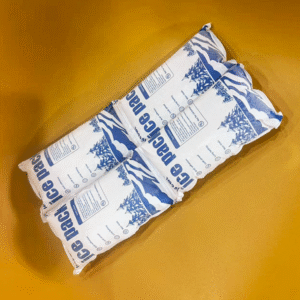Dry ice packs are essential in shipping perishable goods, keeping items cold during transit. No entanto, proper disposal of these ice packs is crucial for safety and environmental protection. Neste guia, we will explore the safest methods for disposing of dry ice, addressing potential risks and providing actionable solutions to ensure responsible handling.
-
How can you safely dispose of dry ice packs?
-
Why is proper disposal of dry ice packs important for safety?
-
What are the potential risks associated with improper dry ice disposal?
-
Where can dry ice packs be disposed of safely?
-
Additional helpful tips on handling dry ice packs
How Can You Safely Dispose of Dry Ice Packs?
Gelo seco is solid carbon dioxide (Co₂) and sublimates into gas at temperatures below -78.5°C. When handling dry ice, it is essential to understand the risks associated with improper disposal. The safest way to dispose of dry ice packs is to allow them to sublimate naturally in a well-ventilated area.
Sublimation Process and Its Importance
Dry ice sublimates, transitioning directly from a solid to a gas without turning into liquid. This process is quick but needs to be done in a well-ventilated space to prevent the accumulation of CO₂ gas.
-
Etapa 1: Place the dry ice in an outdoor area or a room with ample ventilation to ensure safe gas dispersion.
-
Etapa 2: Never store dry ice in sealed containers, as the gas buildup can cause an explosion due to pressure.
Pro Tip: Always wear insulated gloves when handling dry ice to prevent frostbite. Avoid touching it directly with bare skin.
What Are the Risks of Improper Disposal of Dry Ice?
Improper disposal of dry ice can lead to significant hazards, including suffocation, frostbite, and explosions.
Suffocation Risks
When dry ice sublimates in an enclosed space, it releases CO₂ gas that displaces oxygen. This can lead to suffocation, especially in poorly ventilated areas. Always ensure there is sufficient airflow when disposing of dry ice.
Frostbite and Injury
Dry ice is extremely cold and can cause severe frostbite if it comes into contact with skin. Always handle it with protective gloves or tongs.
Explosion Hazards
Placing dry ice in a sealed container or trash bag can cause a dangerous buildup of pressure, resulting in an explosion. Never dispose of dry ice in confined spaces or airtight containers.
| Risk Type | Potential Hazard | How to Prevent |
|---|---|---|
| Suffocation | CO₂ gas buildup in confined spaces | Ensure proper ventilation when sublimating dry ice |
| Frostbite | Direct contact with dry ice | Use insulated gloves or tongs to handle dry ice |
| Explosion | Sealed containers causing pressure buildup | Never seal dry ice in any container |
Where Can You Safely Dispose of Dry Ice Packs?
Outdoor Spaces
The best location for dry ice disposal is an outdoor space with good ventilation. You can leave dry ice in an open area to allow sublimation to occur naturally.
Waste Management Facilities
Some local waste management services or hazardous waste disposal centers may accept dry ice for safe handling. Always contact them before attempting disposal.
Reminder: Never dispose of dry ice in trash bins, sinks, or toilets as it can lead to hazardous conditions and environmental harm.
What If You Can’t Wait for Dry Ice to Sublimate?
If you need to dispose of dry ice quickly, placing it outside in a spacious, well-ventilated area can speed up the sublimation process. No entanto, if you’re dealing with large quantities, you might consider hiring a professional disposal service that can neutralize and dispose of it in a controlled manner.
Latest Trends and Innovations in Dry Ice Disposal (2025)
Emerging Technologies for Dry Ice Disposal
As industries move towards more sustainable practices, advancements in dry ice disposal are being developed. Em 2025, more companies are exploring eco-friendly alternatives to dry ice, such as biodegradable gel packs or improved packaging methods that allow for controlled sublimation.
Considerações Ambientais
Although the environmental impact of dry ice is minimal, improper disposal can still have adverse effects, especially in confined spaces. Innovations in packaging and cooling technology are helping minimize waste and environmental footprints.
Dry Ice Disposal FAQs
Q1: How can I tell if my dry ice pack is fully sublimated?
Once all solid CO₂ has evaporated and no residue remains, the sublimation is complete.
Q2: Can dry ice be disposed of in the trash?
Não. Dry ice should never be thrown into the trash. The CO₂ buildup can cause an explosion in sealed spaces.
Q3: Can dry ice harm my pets or plants if disposed of outdoors?
Não, as long as the dry ice is in a well-ventilated area, it poses no risk to plants or pets. No entanto, keep pets and children away during the process.
Conclusion and Recommendations
Proper disposal of dry ice is essential to ensure safety and protect the environment. By following the guidelines mentioned in this article, you can safely handle and dispose of dry ice packs without posing any risk to yourself or others.
PRÓXIMOS PASSOS:
-
Always ensure dry ice sublimates in a well-ventilated space.
-
Contact your local disposal service for professional assistance with large quantities.
-
Stay safe by using proper handling techniques like gloves and ensuring the disposal area is secure.
Sobre Tempk
Tempk specializes in providing temperature-controlled shipping solutions and safe dry ice disposal practices. Our expertise in the cold chain industry ensures that your products are delivered in optimal conditions.
Get in touch with us today to learn more about our safe handling and disposal services.
























